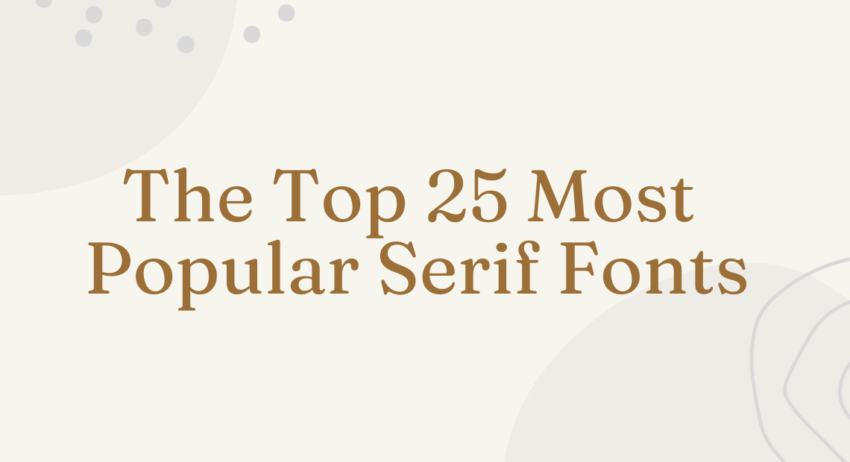In a world saturated with endless digital innovations and graphic design trends, the timeless allure of serif fonts remains unshaken. These fonts, characterized by their distinctive tails or ‘serifs’ at the ends of strokes, are not just remnants of a bygone era but pivotal elements that continue to inject sophistication, readability, and a classical ethos into various projects. As we navigate through 2023, the selection of the right font becomes ever more critical in setting the tone and personality of your work, be it in print or digital media. This guide delves into seven serif fonts that have stood the test of time, proving their worth as indispensable tools in a designer’s arsenal. With each font, we aim to uncover the unique charm and functional benefits it offers, ensuring your projects not only catch the eye but also resonate with your audience on a deeper level.
Understanding the Appeal of Serif Fonts
The enduring popularity of serif fonts in the design world speaks volumes about their versatility and visual appeal. But what exactly makes them so appealing? Beyond their aesthetic charm, serif fonts are engineered to enhance legibility and comfort in reading. The small lines or serifs attached to each letterform guide the eye along lines of text, making it easier for readers to follow and digest large blocks of text. This attribute is invaluable in both print and digital realms, where the ease of reading can significantly impact the viewer’s engagement and comprehension.
The Timeless Seven: Fonts That Never Fade
A Journey Through Time and Typography
In the realm of design, the choice of font can be as pivotal as the color palette or imagery used. This holds especially true when it comes to serif fonts, whose enduring charm and versatility have captivated designers and audiences alike for generations. Let’s embark on a journey through time, exploring the unique stories and characteristics of seven serif fonts that have become staples in the designer’s toolkit, standing strong as testaments to the timeless nature of good design.
Times New Roman: The Quintessential Classic
Times New Roman is not just a font; it’s a piece of history. Born out of a collaboration between The Times newspaper in London and the typographer Stanley Morison in 1931, this font was designed to improve legibility and save space in the newspaper’s columns. Today, it stands as the epitome of formality and efficiency, making it a top choice for academic papers, business communications, and any project where clarity and tradition are paramount.
Garamond: A Touch of Renaissance Elegance
Garamond takes us back to the 16th century, a time when typography was an art mastered by few. Named after the French engraver Claude Garamond, this font is celebrated for its classic elegance and has been used in the print of countless literary works over the centuries. Its refined appearance and excellent readability make Garamond a favorite for book design and long texts that demand a touch of sophistication.
Georgia: The Screen-Friendly Serif
In the digital age, Georgia emerges as a hero for online readability. Designed by Matthew Carter in 1993 specifically for screen display, Georgia features wider characters and a robust x-height, ensuring clarity even on low-resolution screens. Its modern yet approachable look makes it an excellent choice for websites, e-books, and any digital platform seeking to combine aesthetic appeal with functionality.
Baskerville: The Emblem of Transitional Style
Baskerville is a testament to John Baskerville’s passion for printing and typography in the 18th century. This font showcases the transition from Old Style to Modern typefaces, with its greater contrast and more vertical stress. Baskerville’s sharp, elegant serifs and balanced proportions lend a serious, yet beautiful, tone to any printed material, embodying the bridge between tradition and innovation.
Bodoni: Dramatic Contrast, Timeless Impact
Bodoni epitomizes the modern serif genre with its dramatic contrast between thick and thin strokes, a characteristic of the late 18th-century design. Created by Giambattista Bodoni, this font is synonymous with luxury and high fashion, offering a striking visual impact that makes headlines and logos instantly captivating.
Century Schoolbook: Education’s Typeface of Choice
Designed for maximum readability, Century Schoolbook was created in the early 20th century with educational materials in mind. Its open, round shapes and wide letters make it extremely legible for young readers and anyone else who appreciates clear, straightforward text. It’s a font that speaks of trustworthiness and reliability, making it ideal for textbooks, children’s literature, and legal documents.
Caslon: The Old Soul of Typography
Caslon, named after its creator William Caslon I in the 18th century, is often referred to as the “old soul” of typography. Its organic, slightly irregular shapes and moderate contrast give it a warm, human touch that’s as inviting as it is dignified. Caslon has been used in some of the most significant documents in history, including the Declaration of Independence, proving its timeless appeal and versatility.
Incorporating Serif Fonts into Your Design
When choosing a serif font for your project, consider the mood you wish to convey. Each of these seven fonts brings its unique character and historical context, which can significantly impact your design’s overall feel. Mixing and matching serifs with sans-serif fonts can also create dynamic contrasts, adding depth to your layouts.
Conclusion
The journey through the world of serif fonts uncovers a landscape rich with history, versatility, and undeniable beauty. These seven fonts, each with its distinct personality and backstory, offer more than mere aesthetics to your projects. They bring a level of sophistication, readability, and a timeless quality that can elevate any design from ordinary to extraordinary. As we look to the future, the role of these serif fonts in crafting narratives, building brands, and creating immersive experiences remains unmatched. Their ability to adapt to both traditional and modern design paradigms makes them invaluable tools in a designer’s toolkit. Choosing the right serif font is not merely a design decision; it’s a strategic move that can significantly influence how your message is perceived. Whether you aim to evoke elegance, trustworthiness, or classical beauty, there’s a serif font that can meet your project’s needs while ensuring it stands out in a crowded digital landscape.
FAQs
1.What makes serif fonts particularly suitable for print projects?
Serif fonts enhance readability in print by guiding the eye along lines of text, making them ideal for long-form content and books.
2.Can serif fonts be used in digital design?
Absolutely! Fonts like Georgia were specifically designed for digital screens, offering excellent readability and elegance in digital formats.
3.How do I choose the right serif font for my project?
Consider the project’s context, your audience, and the message you wish to convey. Each font has its unique characteristics and historical background that can add depth to your design.
4.Are there any rules for mixing serif and sans-serif fonts?
While there are no strict rules, a good practice is to contrast fonts based on their character. Pair a bold sans-serif headline with a subtle serif body text for a balanced design.
5.Where can I find these fonts?
Most of these fonts are readily available through font libraries or digital design tools. Some may require purchase or a subscription to access.

